Wondering why your pothos cuttings are rotting? Here are the top causes of pothos cuttings rotting, what to do about it, and how to fix it!
Pothos, also known as devil’s ivy, is a popular indoor plant due to its hardiness and ease of propagation.
Many plant enthusiasts enjoy propagating their pothos by taking stem cuttings and rooting them in water or soil.
However, sometimes these cuttings can start to rot instead of rooting properly, leaving plant owners wondering what went wrong.
In this article, we will explore the reasons why pothos cuttings may be rotting and provide tips on how to prevent this from happening in the future.
Whether you’re a seasoned plant parent or just starting out, understanding the common causes of pothos cutting rot can help you achieve a successful propagation and grow a healthy, thriving pothos plant.
What do rotten plant cuttings look like?
Rotten plant cuttings will be brown or black and mushy. If they are in water, it will probably look foggy or brown. It often has a stinky foul odor.
Pothos water propagation root rot is not super common but can easily happen under the right – or, you might say wrong – circumstances.
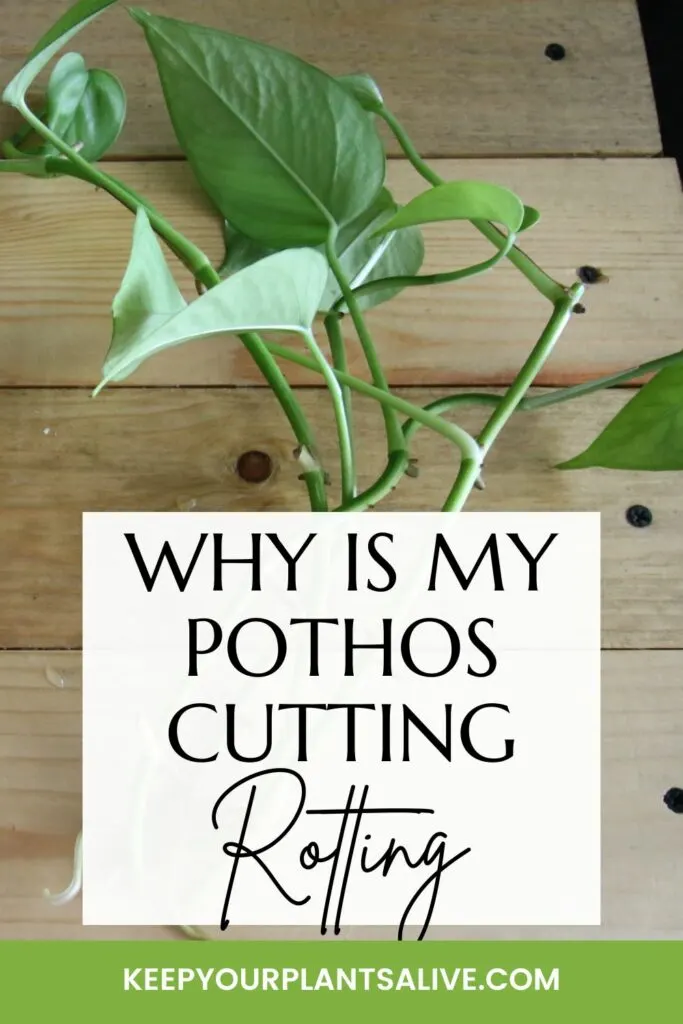
Common Causes of Rotting Pothos Cuttings
Some of the most common causes of rotting cuttings include:
- Lack of oxygen
- Leaves in the water
- Fungal or bacterial infections
- Exposure to cold temperatures
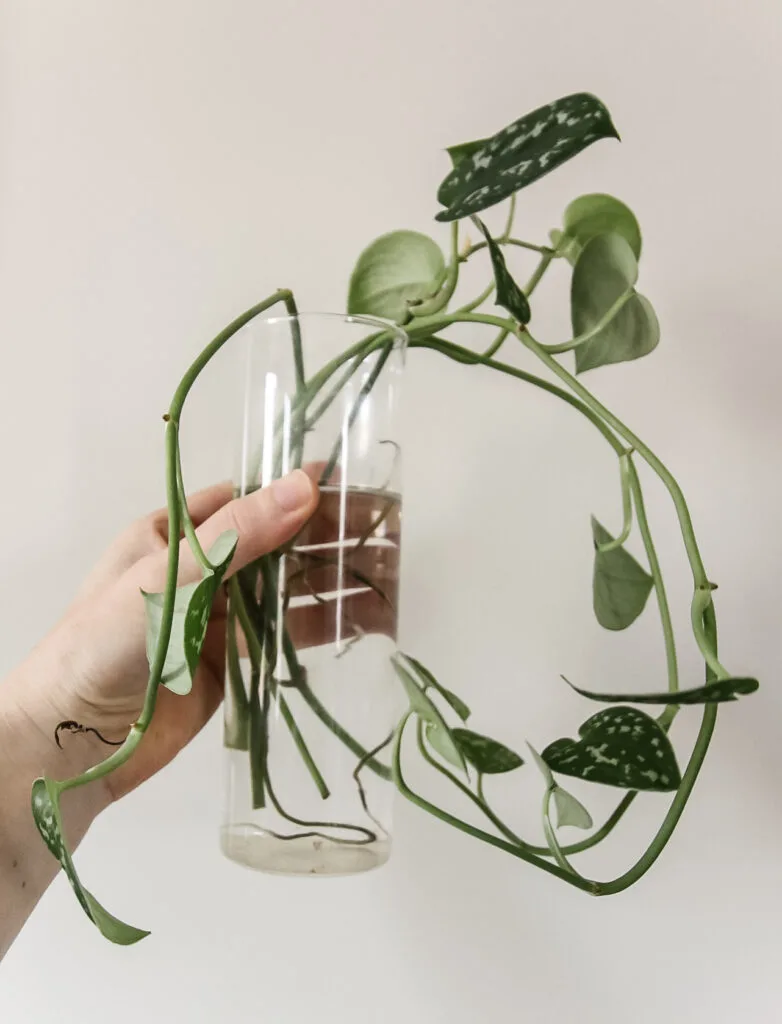
Lack of oxygen
Plants absorb oxygen as well as other nutrients through their roots. As your plant sits in water, it releases carbon dioxide and absorbs all of the oxygen.
If you don’t change the water, it can run out of oxygen. This is the #1 cause of water propagation stem rot & root rot.
Luckily the answer is easy – change the water!
Leaves in the water
Always remove any leaves that will fall into the water on your pothos. Wet leaves will almost always rot.
Fungal or bacterial infections
Plant cuttings are as susceptible to infections as any other plants. Examine them – and the plants around them – for signs of infections. This usually looks like yellow, tan, brown/reddish or black spots on leaves.
Exposure to cold temperatures
Wild fluctuations in temperatures – especially cold – can kill pothos cutting and lead to them getting mushy. They might not actually be rotten, but the end effect is the same!
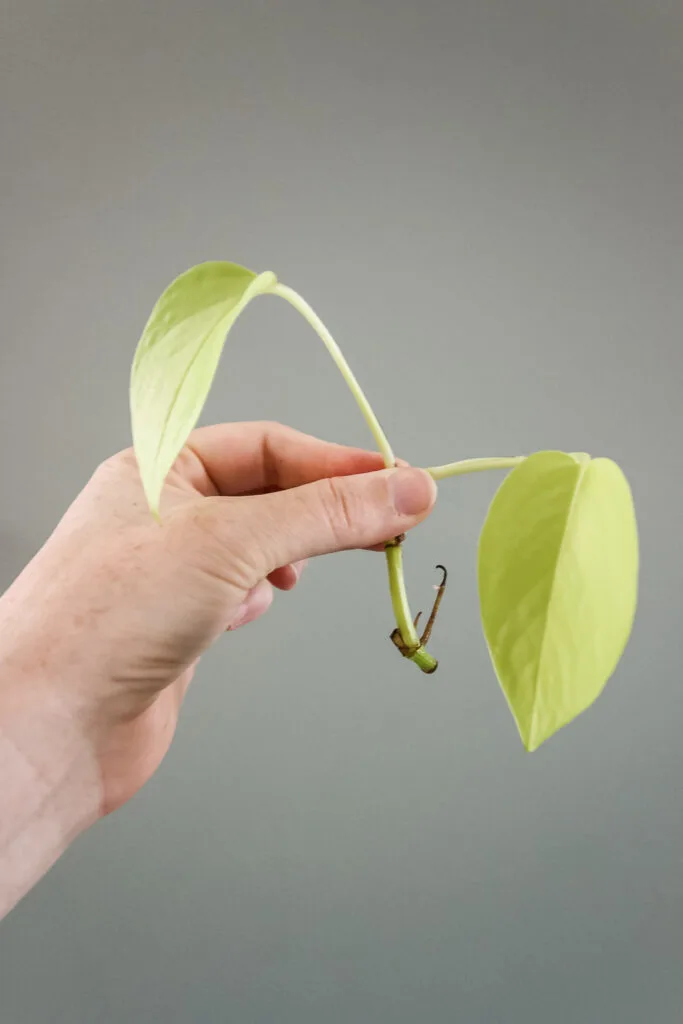
How to Prevent Rotting Pothos Cuttings
Providing proper air circulation
The easiest thing to help prevent water propagation root rot is to change the water regularly – about once a week. This ensures that there is plenty of fresh oxygen in the water and helps it from getting foggy or smelly, too.
Treating infections with fungicides or pruning affected areas
Rotten plant pieces can be dipped in 3% hydrogen peroxide. I have personally not tried this, though it is a common suggestions.
I highly recommend pruning any rotten pieces as soon as you notice them to try to avoid the rot spreading.
Keeping cuttings away from cold drafts
Keep your cuttings in a place with consistent temperatures and no cold or hot drafts. Watch out for vents!
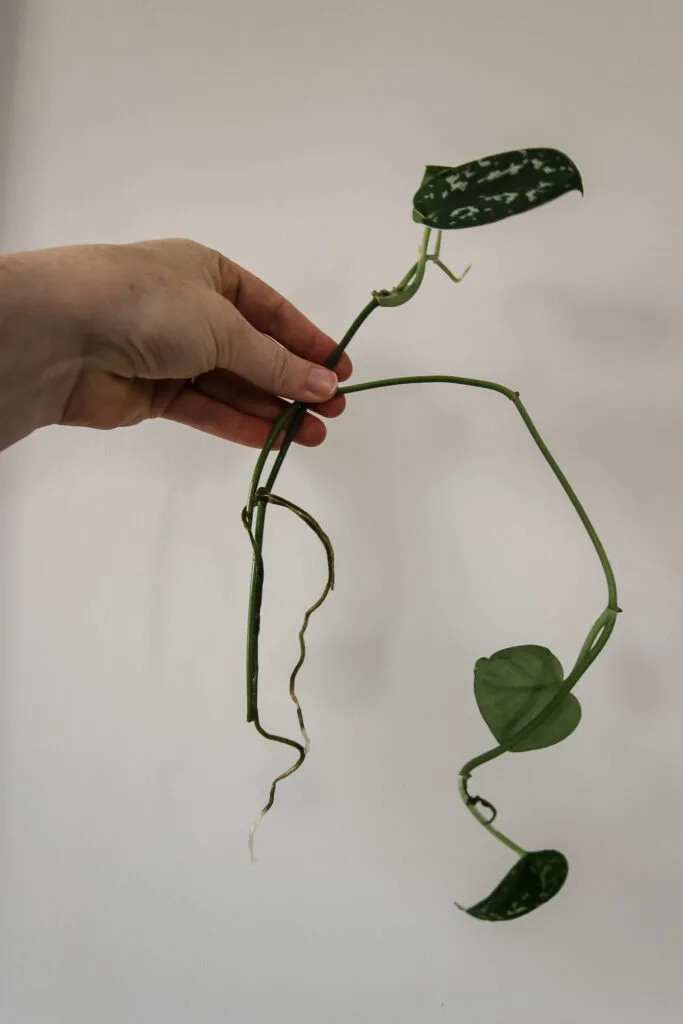
How to Fix Root Rot
If your pothos cutting is already rotting, you have two options.
One, give up and throw it away.
Or, use sterile scissors to carefully remove any rotten stem or roots. This is anything black or mushy. It will not come back to life.
Dump the water, clean the container, and refill it with fresh water.
Place the container in bright, indirect light and monitor it to see if it does better moving forward.
Tips for Healthy Pothos Cuttings
Here are some tips to ensure your pothos cuttings stay healthy:
- Always use clean and sharp tools for cutting
- Only take cuttings from healthy parent plants
- Place cuttings in a warm and humid environment – covering loosely with a clear plastic bag can help to create a “greenhouse effect”
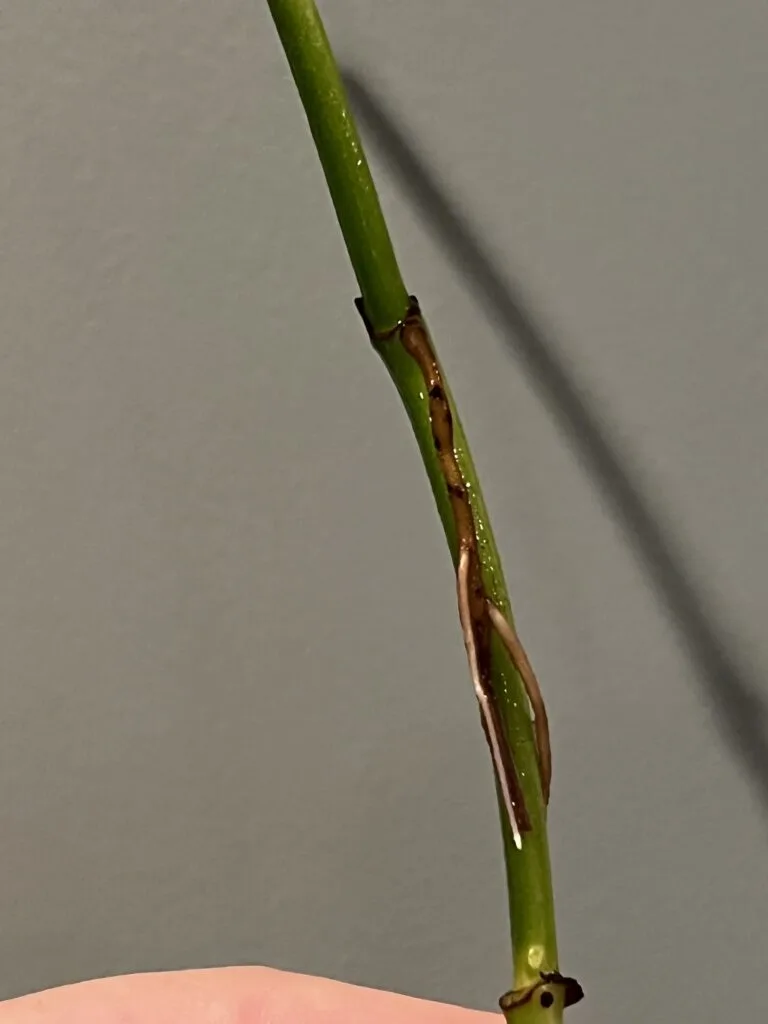
Avoid these Common propagation mistakes
- taking cuttings from an unhealthy plant – withered leaves won’t suddenly come to life as a cutting
- using dirty tools to take cuttings – this can spread diseases
- using blunt tools – clean cuts heal and root easier in general
- forgetting to replace the water – this leads to a lack of oxygen and stem and root rot
- cutting in the wrong place – you need a node for pothos water propagation
Any more questions about rotting pothos cuttings?
Other pothos content you might enjoy:
- Golden pothos care guide
- Cebu Blue pothos care guide
- Baltic Blue pothos care guide
- Marble Queen pothos care guide
- Global Green pothos care guide
- Neon pothos care guide
- NJoy Pothos Care Guide
- Why are my pothos leaves turning yellow?
- Why are my pothos leaves turning brown?
- Why is my pothos plant not growing leaves?
- Why are my pothos cuttings rotting
- How to move pothos from water to soil
- Should I mist my pothos?
- How to make pothos fuller
- Can you propagate pothos without a leaf?
- Can you propagate pothos from a leaf?
- Can you propagate a long pothos vine?
- Where to cut pothos for propagation
- Pothos vs Snake plants: which is better for beginners?
- Cebu Blue Pothos vs Baltic Blue Pothos
- How to propagate pothos
- How to propagate golden pothos
- How to propagate a satin pothos
- How to propagate pothos in soil
- How often to water pothos plants
- How to care for variegated pothos
- How to revive a dying pothos plant
- Why are my Pothos leaves curling?
- How to identify and treat common pothos pests
- How to divide pothos plant
- How to make pothos grow bigger leaves
- Why does my pothos only have one vine?
- Can you grow pothos in low light conditions?
- How to cut off dead pothos leaves
- Are pothos plants toxic to cats and dogs?
- Can you grow pothos in water?
- Why is my pothos droopy?
- Why is my pothos plant dropping leaves?
Printable Pothos Plant Care Guide
Join the (free!) KeepYourPlantsAlive+ community to access this exclusive printable plant care guide! Or keep scrolling for more!
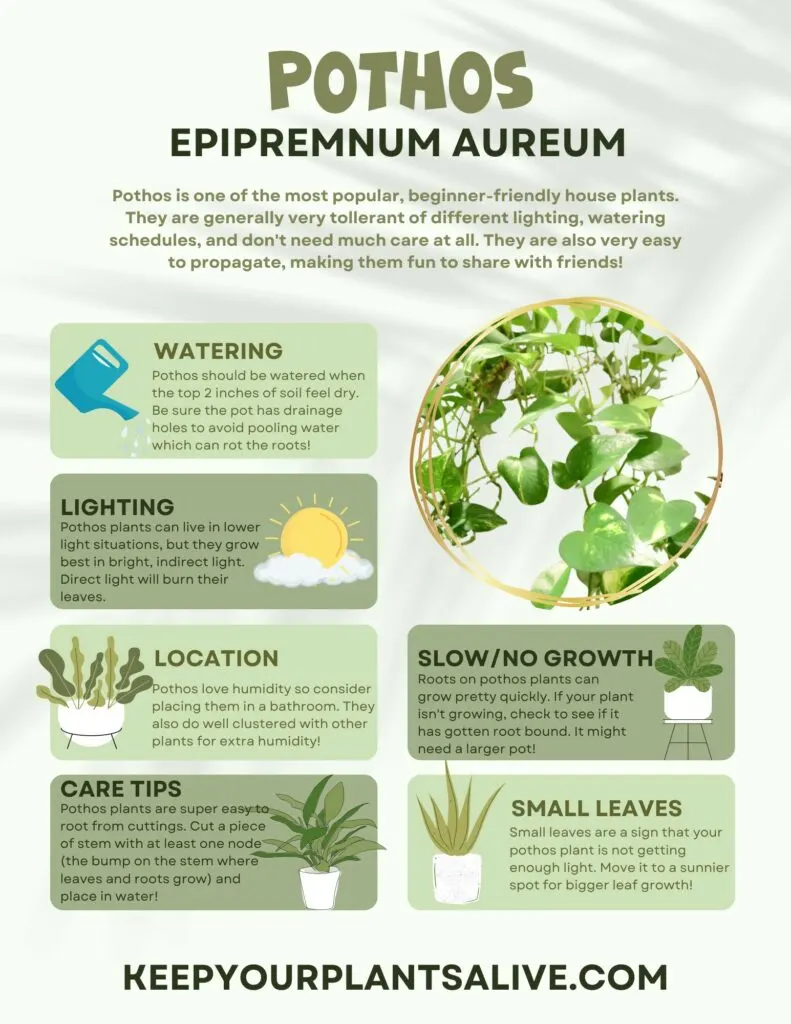
Thanks for reading!


Hey there, I’m Morgan, a houseplant enthusiast from sunny Charleston, South Carolina. Growing up surrounded by my mom’s lush orchids and African violets, I discovered the magic of bringing nature indoors. Thanks to the pandemic, I delved deeper into houseplants, discovering their power to uplift moods and transform spaces. I’m here to spill all my secrets, helping you pick the perfect houseplant – and make it happy. Let’s keep your plants alive, together! 😊
